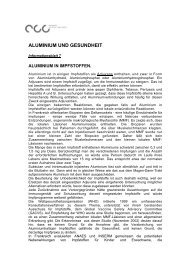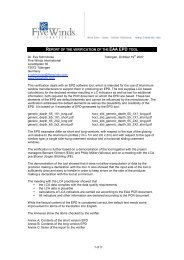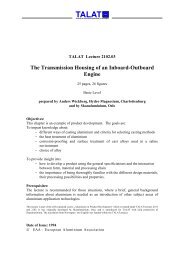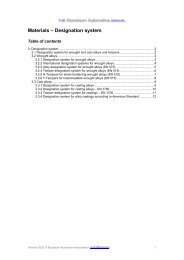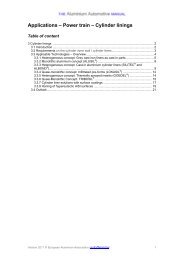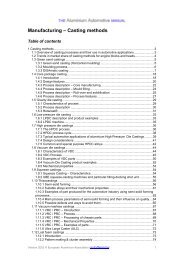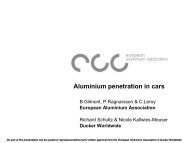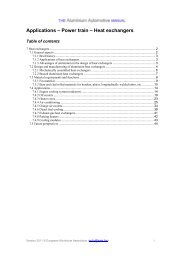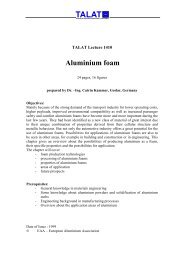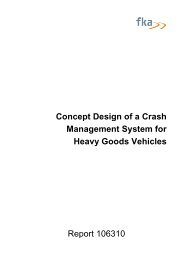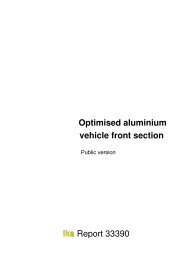aluminium in commercial vehicles - European Aluminium Association
aluminium in commercial vehicles - European Aluminium Association
aluminium in commercial vehicles - European Aluminium Association
Create successful ePaper yourself
Turn your PDF publications into a flip-book with our unique Google optimized e-Paper software.
EUROPEAN ALUMINIUM ASSOCIATION ALUMINIUM IN COMMERCIAL VEHICLES CHAPTER X 142<br />
Clean<strong>in</strong>g before pa<strong>in</strong>t<strong>in</strong>g (LAG)<br />
To apply a degreas<strong>in</strong>g solvent<br />
properly, it is necessary to wipe<br />
the surface with a fresh moistened<br />
cloth and then clean it<br />
with a new, fresh and dry cloth.<br />
Alum<strong>in</strong>ium has amphoteric properties,<br />
which means that it can<br />
be dissolved either <strong>in</strong> an acidic or<br />
alkal<strong>in</strong>e environment. Etch<strong>in</strong>g of<br />
<strong>commercial</strong> <strong>vehicles</strong> is normally<br />
done by apply<strong>in</strong>g the etch<strong>in</strong>g<br />
agent by spray<strong>in</strong>g. Alkal<strong>in</strong>e etch<strong>in</strong>g<br />
agents are based on caustic<br />
soda, silicates, phosphates, carbonates<br />
and sodium hydroxide.<br />
The concentration of sodium<br />
hydroxide and the temperature<br />
of the etch<strong>in</strong>g agent have a large<br />
<strong>in</strong>fluence on the speed and rate<br />
of the etch<strong>in</strong>g process. Etch<strong>in</strong>g<br />
can also be done on the base of<br />
acidic solutions with phosphoric<br />
acid or nitric acid. Etch<strong>in</strong>g leaves<br />
a rough and very moisture-sensitive<br />
surface beh<strong>in</strong>d. It is therefore<br />
essential to r<strong>in</strong>se carefully with<br />
fresh water after etch<strong>in</strong>g (about<br />
20 m<strong>in</strong>utes).<br />
Mechanical treatment<br />
by gr<strong>in</strong>d<strong>in</strong>g or blast<strong>in</strong>g<br />
Gr<strong>in</strong>d<strong>in</strong>g is to be done on a clean<br />
and degreased surface to prevent<br />
oil be<strong>in</strong>g trapped <strong>in</strong>to the <strong>alum<strong>in</strong>ium</strong>,<br />
which could lead to adhesion<br />
problems of the pa<strong>in</strong>t. The gra<strong>in</strong><strong>in</strong>g<br />
of the gr<strong>in</strong>d<strong>in</strong>g disk should<br />
have a gra<strong>in</strong> size of 120-180.<br />
Blast<strong>in</strong>g allows a more uniform<br />
treatment of the vehicle and<br />
reaches areas which cannot be<br />
reached by a manual gr<strong>in</strong>d<strong>in</strong>g<br />
mach<strong>in</strong>e. It is essential to use<br />
iron-free blast<strong>in</strong>g abrasives like<br />
non-recycled corundum, as iron<br />
can lead to corrosion problems1 .<br />
The rate of abrasion dur<strong>in</strong>g blast<strong>in</strong>g<br />
is very low and well below<br />
0.1 mm and therefore <strong>in</strong> the<br />
same range as etch<strong>in</strong>g.<br />
After gr<strong>in</strong>d<strong>in</strong>g (which is also used<br />
to flatten the weld<strong>in</strong>g seams and<br />
to plane out scratches) or blast<strong>in</strong>g<br />
it is necessary to remove<br />
traces of the abrasives by compressed<br />
air and then to clean the<br />
surface aga<strong>in</strong>.<br />
1. The <strong>in</strong>crustation of iron particles on<br />
the <strong>alum<strong>in</strong>ium</strong> surface is a source of galvanic<br />
corrosion that will lead, <strong>in</strong> the<br />
presence of moisture, to superficial<br />
micro-pitt<strong>in</strong>g.



